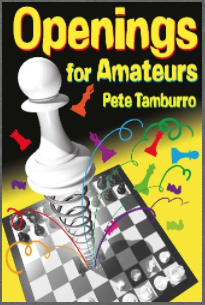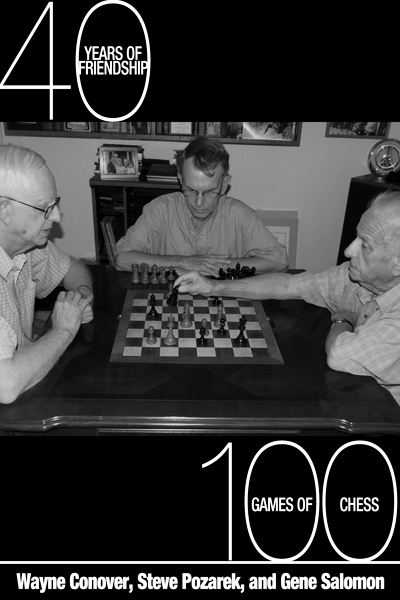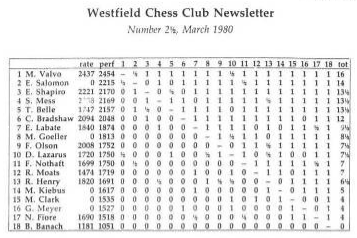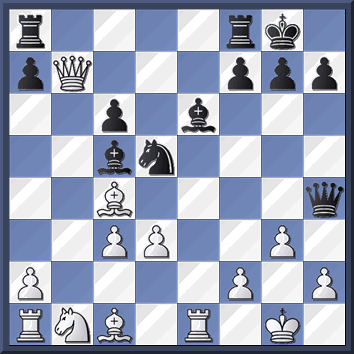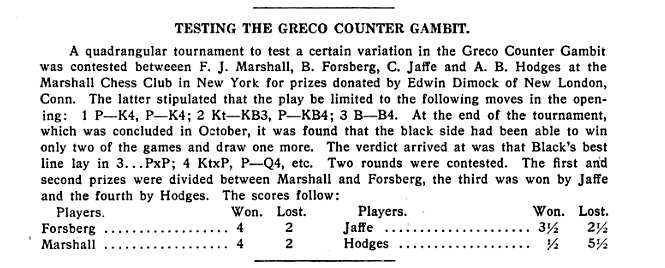The book is divided into two halves: "The Primer: Mistakes in the Opening Most Often Made by Amateurs, and Other Worries" (comprised of general opening advice with illustrative games and examples) and "Openings for Amateurs" (comprised of an opening repertoire with illustrative games and analysis). The first half will mostly appeal to players rated between 1100-1900 (from advanced beginners to club players), while the second half has a lot to offer any players looking to expand their repertoires. But even stronger players would do well not to skip the Primer, since it is chock full of useful "bonus" lines and repertoire analysis, so that the two halves really form a coherent whole in the end. The material to illustrate principles in the Primer is usually drawn from basic or less important lines that are part of the repertoire -- such as ideas for meeting the King's Gambit, Danish, Halasz Center Gambit, and Vienna Gambit (part of an Open Games repertoire for Black), or the Grob and Orangutan (which you are bound to meet at some point). There is also a nice section titled "When Facing Some of the 'Pre-Planned' Openings, Don't Be Afraid to Have Your Own Plan Ready to Go," which offers a coherent repertoire for counter-attacking the Colle, Barry, and Zuke. Tamburro fills the Primer with interesting bonus material like this, also discussing some openings that don't make it into the repertoire such as the Barry Attack and Colle for White (not a bad 1.d4 repertoire) and C.J.S. Purdy's "All-Purpose Defense" for Black with ...e6, ...d5, and ...c5, leading to a French or Tarrasch Defense depending on White's choices.
Most players will find the "Openings for Amateurs" repertoire portion of the book to be its main attraction. As a player who has always played "amateur" lines, I liked Tamburro's opening choices a lot and was surprised at how many were already part of my repertoire or had been in the past. Then it slowly dawned on me that I have known Tamburro's work for well over a decade, so he has already had his influence on me!
Tamburro recommends a repertoire built around 1.e4 for White. For Black against 1.e4 he suggests either 1...e5 (heading toward sharp Open Games) or 1...c5 (heading toward the Sicilian Dragon). And for Black against 1.d4 he recommends either 1...Nf6 (heading toward the Nimzo-Indian or Bogo-Indian) or 1...f5 (heading toward the Stonewall Dutch). Along the way, he also discusses the Reversed Dragon line of the English, which can be used for White or Black. Typically, each chapter here will discuss a number of interesting options before focusing on the repertoire line, so there is plenty of bonus material here as well.
The principles that Tamburro uses in choosing an opening include that it: does not require a lot of memorization, follows general principles, makes you feel comfortable, makes your opponent uncomfortable, and is an opening "you can grow with" (meaning it doesn't allow a known equalizing line or have a known refutation that your stronger opponents are sure to know). For the remainder of this review, I'd like to take a closer look at this repertoire, which seems very well chosen for its intended reader:
Sicilian Defense, Chekhover/Rossolimo, Closed and Alapin (1.e4 c5)
Tamburro starts in the right place, as the Sicilian is the line you are most likely to face if you open with 1.e4. To help combat this important defense, he discusses three alternatives which will appeal to a variety of styles. After all, one of his key principles is that you need to choose openings that you feel comfortable playing.
I especially like the lines with Bb5 for White. Tamburro recommends 1.e4 c5 2.Nf3, meeting 2...d6 with 3.d4 cxd4 4.Qxd4 Nc6 5.Bb5 and 2...Nc6 with 3.Bb5 or an Alapin-like 3.c3 (covered later). He also discusses possible transposition to Alapin-like lines if Black chooses 2...e6. Sample games here include Tal–R. Byrne, Biel Interzonal 1976; J. Polgár–Shirov, Las Palmas 1994; Vojtek–Debnar, Slovak Team Chp. 1997; Firat–Reshetnikov, Moscow 2013; Rossolimo - Müller, Bad Gastein 1948; Rossolimo - Kottnauer, Bad Gastein 1948; and Rossolimo - Romanenko, Salzburg 1948. The coverage of the Chekhover is first-rate and includes material I wish I had seen before writing my own "Notes on the Chekhover Sicilian (B53)."
The closed line with 1.e4 c5 2.Nc3 followed by 3.g3 is another good option for players seeking to limit their theory. Sample games here include Smyslov–Denker, USA-USSR Radio Match 1946 and Spassky–Geller, Candidates’ Match (6) 1968. Though I usually play the Grand Prix Attack myself (another amateur favorite), I have also tried the Closed with g3, especially as a way of addressing the move order 1.e4 c5 2.Nc3 a6!? when White's light-squared Bishop will probably be most comfortable fianchettoed. I learned a lot about this line from analyzing Capablanca - Zhenevsky, Moscow 1925, which demonstrates the strategic depth of the opening for both players, and from IM Attila Turzo's excellent video The Basic Principles of the Closed Sicilian for White (ChessLecture) which covers some of the same territory that Tamburro does.
Finally, the c3 Sicilian is a completely different animal but also a good system for amateurs, some of whom might also want to experiment with the Smith-Morra (which is definitely not a line that Tamburro recommends, let me be clear!) Samples games include Alekhine–Podgorny, Prague 1943 and Sveshnikov–Bonsch, Cienfuegos 1979. All-in-all, a great set of options for meeting the Sicilian, and definitely all lines you can "grow with."
French, Tarrasch Variation (1.e4 e6 2.d4 d5 3.Nd2)
This is a good approach to the French and fits well with other recommendations, especially the c3 Sicilian (which Tamburro shows can reach similar positions). Illustrative games include Rublevsky–Dyachkov, Russia Club Cup 1998; Karpov–Kuzmin, Leningrad Interzonal 1973; and Tiviakov–Zhang Pengxiang, Olympiad 2006.
Caro-Kann, Fantasy Variation (with 1.e4 c6 2.d4 d5 3.f3!?)
Probably one of Tamburro's most surprising recommendations is the Fantasy Variation, which has been an interest of mine (see my bibliography on the Fantasy Variation of the Caro-Kann, for instance) and a line that I definitely plan to return to after reading this chapter! I would recommend the recent book Extreme Caro-Kann by Alexey Bezgodov for serious students. Sample games here include Tatai - Mariotti, Reggio Emilia 1967-68; Smyslov - Gereben, Moscow vs Budapest 1949; and Robson–Shankland, U.S. Junior Ch. 2010 (where Tamburro has some improvements on White's play). Interestingly, in his excellent earlier book Learn Chess from the Greats, Tamburro gave a "?!" mark in his annotations to White's third move. Clearly he has had a change of heart over the years!
Austrian Pirc (1.e4 d6 2.d4 Nf6 3.Nc3 g6 4.f4)
I have been one of many players inspired by Tamburro's "Openings for Amateurs" lectures at ICC/ChessFM, where he presented on the line 1.e4 d6 2.d4 Nf6 3.Nc3 g6 4.f4 Bg7 5.e5 dxe5 6.dxe5!? exchanging Queens to achieve a favorable ending. I wrote about this line in the article "The Simplified Pirc." It's definitely a solid system that will teach you a lot about chess and score you many points. And if Black does not exchange pawns in the center, he will be under quite a bit of pressure. Sample games include Bronstein–Benko, Monte Carlo 1969 and Z. Polgár–Shchekachev, Vienna 1991.
Canal Variation of the Alekhine's Defense (1.e4 Nf6 2.e5 Nd5 3.d4 d6 4.Bc4)
I have from time to time experimented with a "Mad Dog" opening repertoire built around 1.e4 with an early Bc4 for White against most everything Black can play, and it naturally features the Canal Variation against the Alekhine with 4.Bc4 (though I have also experimented with the gambit line of the Chase Variation with 3.c4 Nb6 4.c5 Nd5 5.Bc4!? as well). I agree with Tamburro's view that Canal's approach is underestimated by theory and I was glad to see him discuss it. Sample games include Canal–Pérez, Madrid 1951, and Sax–D. Burić, 2002.
Scandinavian (1.e4 d5 2.exd5)
I like Tamburro's repertoire against the Scandinavian, especially 2...Qxd5 3.Nc3 Qa5 4.Bc4 Nf6 5.d3!? which I play also, ever since I saw Andrew Martin mention that it might be White's "most dangerous" option. Tamburro also covers some of my favorite attacking lines, including the sharp 2...Nf6 3.d4 Nxd5 4.c4 Nb6 5.Nf3 Ng4 6.c5! N6d7 7.Bc4, which is another one of those "Mad Dog" lines where the Bishop aims at f7. Sample games include Houska–Keitlinghaus, Bundesliga 2003/04; Losev–Orlinkov, Moscow 2010; R. Byrne–Rogoff, U.S. Chp. 1978; and Lisetskaya–Everitt, ICCF 2011.
Spanish Four Knights (1.e4 e5 2.Nc3 Nf6 3.Nf3 Nc6 4.Bb5)
About eight years ago I visited Fred Wilson at his book shop in New York City, where he completely sold me on the Spanish Four Knights by calling it a "real man's" opening -- because it leads to hand-to-hand combat and has been played by some of the toughest players in chess history. Following Wilson's recommendations, I played and analyzed it quite a bit (see my bibliography and articles one, two and three on the line in what should have been a much longer series). On the only occasion that I visited Pete Tamburro at his home, we discussed our mutual interest in the Four Knights and he photocopied some fascinating historical analysis for me from the January 1922 issue of British Chess Magazine (which he also discusses at length in his book). The article he copied recommended meeting Rubinstein's 4...Nd4 with the simple 5.O-O! -- the same line I had learned from Wilson and discussed in my first article. Sample games in this chapter include Capablanca–H. Steiner, Los Angeles 1933; Maróczy–F. Treybal, Prague 1908; and Perlis–Freymann, St. Petersburg 1909. Besides those books mentioned in my bibliography, there are also the more recent The Four Knights Game by Andrey Obodchuk and The Four Knights: Move by Move by Cyrus Lakdawala -- the latter of which also discusses the next line via Glek's move order.
Paulsen Vienna with g3 (1.e4 e5 2.Nc3 Nf6 3.g3)
This line has been a favorite of mine, as I discuss in my Glek Four Knights and Paulsen Vienna Bibliography. It really fits the bill for an opening that you can play on general principles without a lot of memorization. Sample games from the book include Motwani–B. Jónsson, Iceland 1992 and Bisguier–Snow, U.S. Amateur Team East 2013.
Open Games as Black (1.e4 e5 2.Nf3 Nc6)
I have always been attracted to the open games for both White and Black, and there are many good opening manuals to support that choice (John Emms's Play the Open Games as Black is still a favorite of mine). I'm glad that Tamburro does not shy away from this approach, as it has always struck me as the most principled defense for Black and the one most likely to lead to fun and interesting games for amateurs. Tamburro recommends the Fritz Variation of the Two Knights Defense against the Italian and main lines against the Scotch. Sample games here include Sachs - Friedman, Cleveland 1948; Spielmann–Eliskases, Match 1936; Showalter–Gossip, New York 1889; and Smeets–M. Adams, Staunton Memorial 2008. In the last chapter of the book, Tamburro discusses the Ruy Lopez as White and Black, recommending the Marshall Gambit for serious students, but also discussing the fun to be had with the Schliemann (3...f5). For those interested, I had a couple of articles on GM Josh Friedel's use of the Fritz-Ulvestad Defense (see first and second) and a webliography and commentary on the Two Knights for Black. I also have an interesting piece on the Anti-Modern 5...Ng4.
Sicilian Dragon (1.e4 c5 2.Nf3 Nc6 3.d4 cxd4 4.Nxd4 g6)
For those who are not up to playing the open games as Black, Tamburro recommends the Sicilian Dragon, which was my own first line (picked up from the classic How to Think Ahead in Chess by Fred Reinfeld and I.A. Horowitz). As Tamburro notes, you don't have to do a lot of deep opening study to get started with this line at the amateur level, but as you climb up the ratings ladder you will have to hit the books -- or at least check out my webliography. Tamburro's sample games include Vasiukov–Parma, Rijeka 1963; M. Burrows–Felgaer, Gibraltar Masters 2013; and Rauzer–Botvinnik, USSR Ch. 1933.
English, Reversed Dragon (1.c4 e5 2.Nc3 Nf6 3.g3 d5 4.cxd5 Nxd5 5.Bg2)
Some years ago we had a "Reversed Dragon" theme tournament at the Kenilworth Chess Club, in which I really enjoyed participating. It definitely convinced me that this is a great line for amateurs, as Tamburro had already discussed in one of his ICC/Chess FM lectures. Here he outlines a repertoire that follows the games of former World Champion Mikhail Botvinnik: Botvinnik–Lundin, Stockholm 1962; Botvinnik–Portisch, Monte Carlo 1968; Botvinnik–Söderborg, Stockholm 1962; and Benko–Botvinnik, Monte Carlo 1968. I think a player who adopted this and the Sicilian Dragon as Black would have an interesting lifetime system.
Nimzo- and Bogo-Indian (1.d4 Nf6 2.c4 e6 3.Nc3 Bb4)
Tamburro makes a great case for the Hübner Variation but also covers a wide range of methods of handling this solid defense. The Hübner was nicely discussed recently by Jeremy Silman in his series "Riding the Winds of Fashion, Part One" and "Part Two" at Chess.com, which should definitely convince you that this is an opening you will learn a lot from playing. Sample games from Tamburro's book include Pinter–Timman, Las Palmas Interzonal 1982; Spassky–Fischer, World Championship 1972; González–Perrine, corr. 1943; Abramavicius–Ribera, Hamburg 1930; and Colle - Capablanca, Karlsbad 1929.
Dutch Stonewall (1.d4 f5 2.c4 Nf6 3.g3 e6 4.Bg2 d5 5.Nf3 c6 6.O-O Bd6)
I had noticed that Tamburro was playing the Dutch Stonewall in recent years, and his interest in the line may have been part of what led me to experiment with it myself. I put together an article on The Stonewall in Black and White, which has been a favorite of readers ever since (probably my most popular article ever to judge from the stats). And the Stonewall definitely has much to recommend it, not least because of its well deserved reputation for leading to super-solid positions. Sample games include Flohr - Botvinnik, Match (10) 1933; Marshall–Chigorin, Ostend 1905; Gurevich - Illescas, Sanxenxo 2004; Kasparov - Illescas, Dos Hermanas 1996; Turner–Agdestein, Tromsø 2008; and Lenic - Kuzubov, World Youth 2005.
Ruy Lopez (1.e4 e5 2.Nf3 Nc6 3.Bb5) Tamburro ends with "A Plea for the Ruy Lopez" as a great line for lifelong learning. But that one fell on deaf ears: like most amateurs, I will do anything to avoid the Spanish Torture, even by "flipping the Bird" at the Lopez Bishop with 3...Nd4!? But this might be the best chapter in the book for those willing to listen.
Overall, this is a great book with much to recommend it. Download an excerpt from the Mongoose website for more details.
